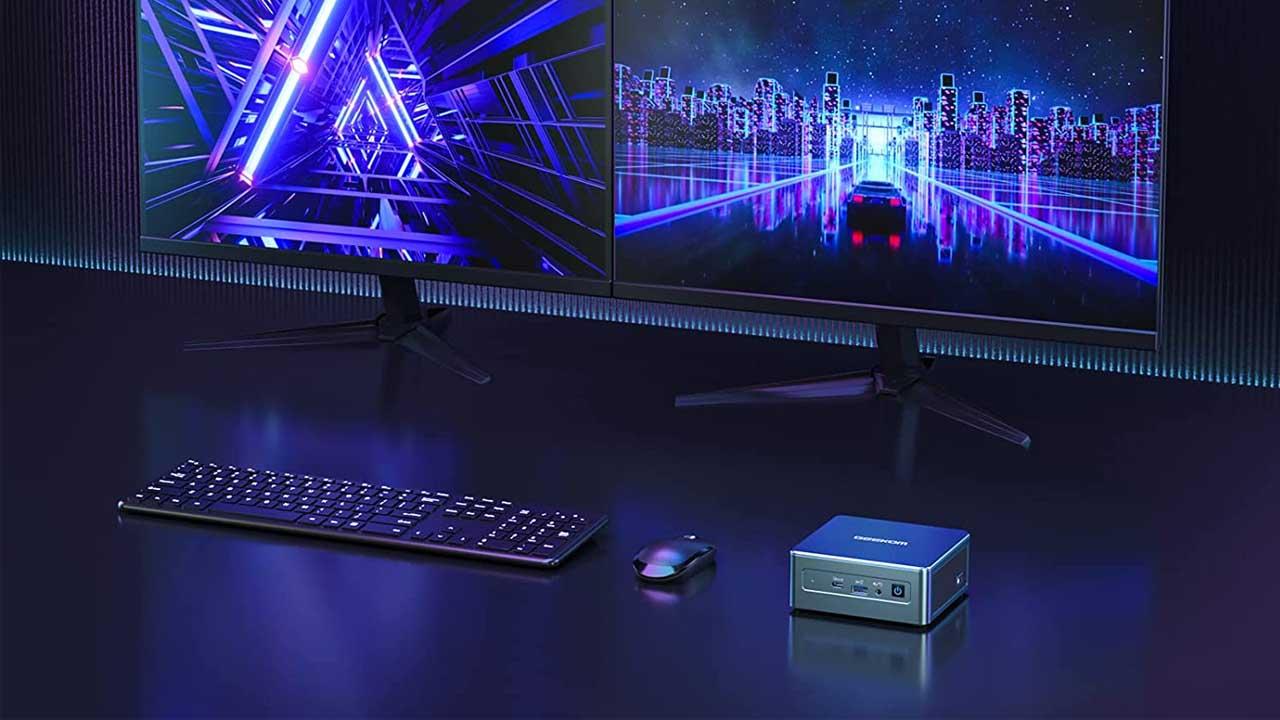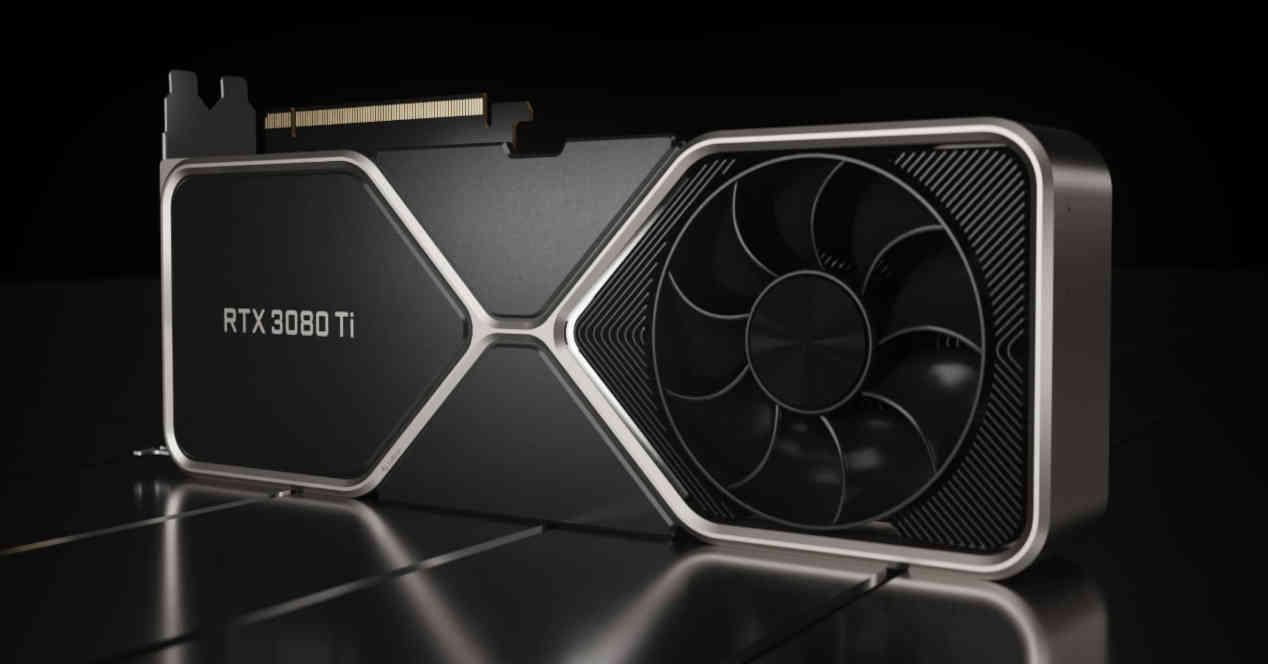
This processor comes with 16GB of RAM 3200 MHz DDR4 on two 8GB SO-DIMMs each, though they can be replaced for up to 64GB of RAM. As for storage, it comes from the factory with a 512GB PCIe 3.0 x4 SSD, which is not the most modern or fastest but it will be more than enough for the purpose of this team. In addition, inside we have a hole to install an additional 2.5″ disk.
Finally, to highlight its wide connectivity that includes a Gigabit RJ45 port and Wi-Fi 6 for network, as well as Bluetooth 5.2 (in this way, if you put it behind the monitor you will only have to connect the power cable and the video cable, since you can connect the peripherals via Bluetooth and the network via WiFi). It also has 3 USB 3.2 and two USB 4 ports, in addition to the usual audio minijack and an SD card reader.
Unboxing and external analysis
The Geekom Mini IT11 comes packed in a luxury hard cardboard box, as it gives us the impression of being in front of a Premium category product. At the top we can see the company logo and, in large, the model of the mini PC, while on the back we simply have a label that lists its hardware.


On the sides, just like Intel does on its NUCs, we have some images that show us precisely the sides of the device, with all its connections and so on.


The box is opened by removing the upper part, and by doing so we can directly see the mini PC protected by plastic and, in turn, encased in a black expanded polystyrene structure to protect its integrity during transport.
Let’s start by looking at what comes in the box besides the mini PC itself; To begin with, we have a “letter” thanking us for purchasing a brand product and a brief instruction manual.
Also included is an HDMI 2.0 cable, the VESA adapter to install it on the back of a monitor as we mentioned before, and the necessary screws to anchor both the mini PC to the VESA mount and a 2.5″ disk that, as we have already mentioned, it can be additionally installed inside.
To finish with the accessories, we also have an external power supply with its European power cord. This power supply is 64.98W and has a standard connector.
Now we are going to see the Mini IT11, which, as we mentioned before, is initially protected by a plastic that we must remove.
Outwardly, the Geekom Mini IT11 looks quite stylish with gray and black colors, but the entire outer casing is made of plastic except for the vents.
Let’s see all its parts: on the front we have, from left to right, a status indicator LED, a USB-C port (USB4), a USB 3.2, a 3.5 mm combo minijack and the power button.
At the back, a hot air outlet grill dominates the entire top. Under it, from left to right we have the power connector, mini DisplayPort, RJ45 Gigabit, two USB 3.2, another USB 4 and the HDMI 2.0 output.
On one of the sides we have an air intake grill and the SD card reader.
While in the other, another grid dominates almost the entire surface, in addition to a Kensington security lock.
We go to the lower area, where we find the same typical structure as in the NUC: four legs with rubberized screws that are the ones that we will have to remove to access the interior, as well as four perforations with rubber covers that we will have to use if we want to use the VESA anchor.
Having seen the device from the outside, let’s see what it hides inside.
This is the Geekom Mini IT11 inside
As we have just mentioned, accessing the interior of the device is as simple as removing the four screws from the legs and pulling it out, giving us direct access to the interior.
In the part that we removed, we have the hole to install a SATA 3 storage device already prepared and connected, so it is simply a matter of inserting it, screwing it and that’s it. If you look closely, in this area they have installed a thermal pad to cool the SSD passively.
Inside the Mini IT11 we have direct and easy access to both the two SO-DIMM RAM memory modules and the M.2 socket, which contains a Lexar NM620 PCIe 3.0 x4 SSD already installed at the factory (the RAM is also Lexar, by the way, and that’s great because we always prefer name-brand hardware to OEM.)
There is no access from here to the WiFi + Bluetooth module, which comes from the bottom (in fact you can see the antenna cables on top of the SSD in the photo above), and changing it would be much more complicated, just like its blower fan, processor, etc. As this is a mini PC designed to plug and play we will not go into it, so we end this section here.
Geekom Mini IT11 performance tests
Actually, to make this mini PC work, we will only need to connect it to the power outlet and to a monitor, because as we have mentioned before, thanks to WiFi we can have an Internet connection and thanks to Bluetooth we can connect a wireless mouse and keyboard, being its use more comfortable and leaving us an aesthetic appearance on the desk that is cleaner and more sober.
However, since the Geekom Mini IT11 comes with Windows 11 Pro installed from the factory, for the initial configuration we will have to connect peripherals via USB before we are given the opportunity to configure other wireless ones; keep that in mind.
That being said, let’s start with the tests, and as we always do, showing you a screenshot of CPU-Z that is going to show us the hardware that it mounts.
As you can see, CPU-Z is not capable of detecting the specific model of the CPU, and it is somewhat strange because it is already a couple of years old… in any case, you already know that it is an Intel Core i7-11390H with 4 cores and 8 threads which can go up to 5GHz at their maximum turbo speed. We can also see the RAM memory, in total 16 GB DDR4 at 3,200 MHz.
On the other hand, this is what GPU-Z tells us about the integrated graph.
In this case, it does detect it perfectly and shows us the integrated Iris Xe that works up to 1,400 MHz, a graph that obviously will not give us to play triple A titles but that can be quite noticeable for simple games, yes. Well it is true that this mini PC is not designed for gaming.
noise and temperature
The biggest problem with mini PCs, and especially those with powerful hardware like this, is that they get quite hot and due to their small size, very good thermal solutions cannot be integrated. In the case of this Geekom Mini IT11, it has a heatsink with a blower fan that cools the processor only and exclusively, that is, we do not have dissipation for the rest of the elements except, as we have seen when looking inside, a thermal pad for the SSD.
However, we can tell you that the equipment has not been noisy at all, not even under maximum load; Yes, it is true that the fan is heard when we are “hitting it”, but unless you have the room in complete silence, you won’t even notice.
As for the temperature, having 23ºC in the room where we have been testing it, the processor remains at about 45-50ºC at rest and reaches 80ºC under load, a temperature that is quite acceptable since it is very far from the limit; However, it would be necessary to see what level of noise and temperature the equipment presents in the long term, for example after a year of daily use.
Synthetic benchmarks
We are going to start with the tests, and as always we proceed first of all to measure the performance of the SSD with Crystal Disk Mark.
We have already seen before that the SSD is PCIe 3.0, but even so those more than 3,400 MB / s of reading and more than 2,600 MB / s of writing turn out to be excellent, making everything work very fast and agile, so nothing what to object
We continue to see the performance of RAM memory, and for this we use Aida64.
The performance that this benchmark shows us is honestly excellent for 3,200 MHz DDR4 RAM, and in fact it is almost at the same level as many LPDDR5 SO-DIMM memories.
But a benchmark is one thing and a real situation another, so to get closer to this we are going to subject the Mini IT11 to a test of SuperPiwhere we will force the processor to calculate 32 million decimal places of the number Pi in an intensive operation for both the processor and RAM.
The result is outstanding, almost at the level of many desktop DDR5 memories, partly thanks to the fact that the Core i7 processor of this mini PC has a very, very good performance.
And speaking of the processor, it’s time to see how it “strikes” if we ask it to render 3D scenes with Cinebench R23.
Here we come across the other side of the coin, and that is that the performance offered by this Core i7-11390H falls a little short for 3D rendering. To give you an idea, the score obtained in both multi-core and single-core performance has been lower than what we can get with a laptop equipped with a low-power Core i7-1355U.
Ok, it is clear that this is not a mini PC designed for 3D rendering, but let’s see what overall performance it offers us with PC Mark 10a benchmark that will measure the performance of the entire team globally in everyday situations (videoconference, browsing, office automation, etc.), where all the hardware elements that make it up are involved.
These practically 4,800 points in PCMark 10 tell us that the performance of the Mini IT11 is notable or notably high, making it clear that it is an excellent mini PC for teleworking tasks.
Finally, and although we have repeated several times that this mini PC with integrated graphics is not intended for gaming, let’s see what results we get in 3DMarkstarting with Fire Strike.
With this result, it is quite clear that this device is not for gaming, probably not even at 1080p resolution and low settings. But let’s see what he says Time Spywhich performs a similar test but using the DirectX 12 graphics API.
Looking at these results, of course this PC is not designed to offer good performance in games and, nevertheless, we can expect excellent performance in multimedia tasks.
Conclusion and verdict
Although it is true that we are not facing the most powerful or cheapest mini PC on the market, the Geekom Mini IT11 has shown us a fairly solid and remarkable performance in all the tests we have subjected it to, making it clear that if you intend to use it to work with the daily tasks that this implies (office automation, navigation, videoconference, multimedia, etc.) you will have equipment for a while.
From our point of view and after having been testing it, this mini PC gives soups with waves to those cheap mini PCs that you can buy for just €200 in all areas, from quality to sound, through performance. In short, we think it’s one of the best options on the market right now if you’re looking for a decent mini PC that doesn’t cost you an arm and a leg to work from home.
For all these reasons, we believe that it deserves our Gold award, as well as our recommendation for its performance / price ratio.




























